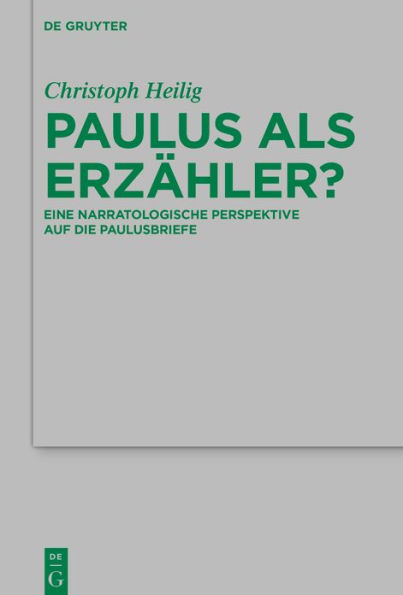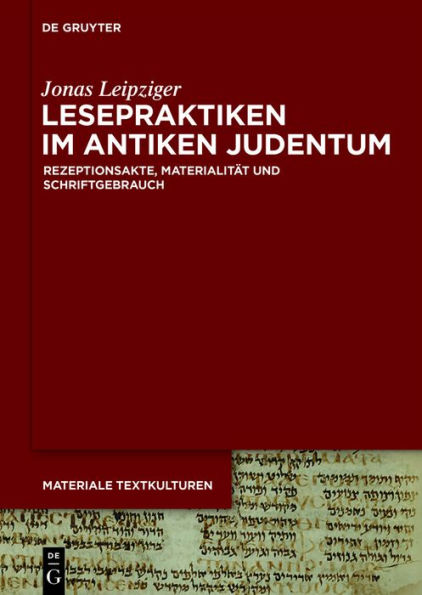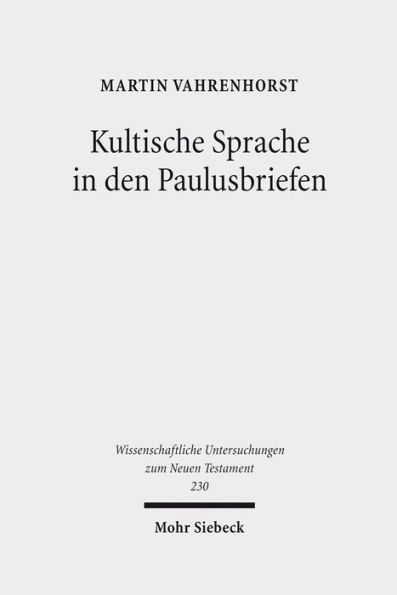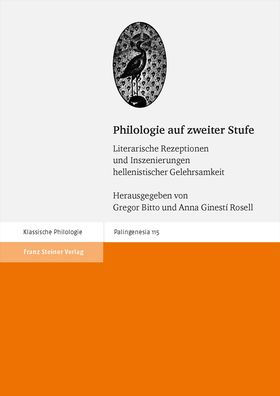Home
Ein 'unertragliches philologisches Possenspiel'?: Paulinische Schriftverwendung im Kontext antiker Allegorese
Barnes and Noble
Loading Inventory...
Ein 'unertragliches philologisches Possenspiel'?: Paulinische Schriftverwendung im Kontext antiker Allegorese in Franklin, TN
Current price: $150.00
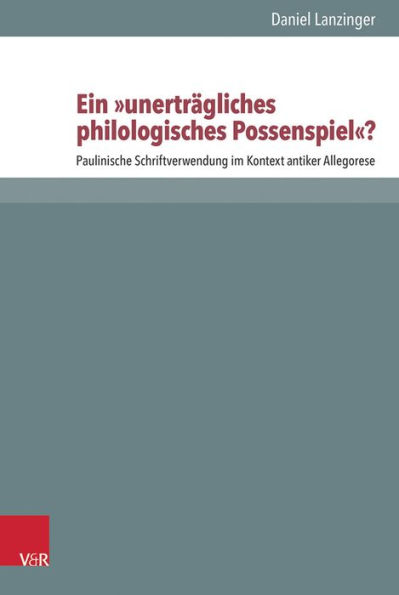
Barnes and Noble
Ein 'unertragliches philologisches Possenspiel'?: Paulinische Schriftverwendung im Kontext antiker Allegorese in Franklin, TN
Current price: $150.00
Loading Inventory...
Size: OS
English summary: How St. Paul dealt with scripture is often viewed because it is far removed from modern standards of textual interpretation. This is particularly true in those passages where Paul employs allegorical interpretations in which the meaning of a text is construed in such a way that it seems to contradict the plain wording of the text. For example, in 1 Corinthians 9:8-12a, Paul advances the argument that the text from Deuteronomy 24:4, which advocates muzzling oxen while they thresh grain, does not refer to oxen but rather to the material support given by Christians to the apostles. Such interpretive positions are only understandable when one takes the ancient concepts of proper textual interpretation as the standard against which to judge Paul's exegesis, rather than modern standards. In this work, Daniel Lanzinger assembles a representative selection of texts that were contemporary with the New Testament (such as works by Heraclitus, Plutarch, Philo, and the writings of Qumran) and analyses which methods were used in contemporary religious traditions. Ancient treatises on rhetoric also prove to be important instruments of analysis for this study. The results of this survey show that allegorical interpretation in the ancient world was concerned with established and accepted interpretive approaches to literature that offered specific guidelines for interpretation. Lanzinger then applies his findings to relevant passages in Paul's writing (such as Gal. 4:21-31, 1 Cor. 9:8-12a, 10:1-14, and Gal. 3:16). This investigation ultimately shows that Paul knew the contemporary methods of allegorical interpretation and he deployed them in his writings in order to emphasis his arguments in an elegant manner. German description: Die Art und Weise, wie Paulus mit der Schrift umgeht, ist vielen Exegeten eher peinlich, weil sie von heutigen Standards der Textinterpretation weit entfernt ist. Ganz besonders gilt dies fur jene Stellen, an denen sich Paulus einer allegorischen Auslegung bedient, d.h. dem Text einen Sinn unterstellt, der dem Wortlaut widerspricht: In 1 Kor 9,8-12a vertritt Paulus beispielsweise die These, dass sich das Verbot, einem Ochsen beim Dreschen einen Maulkorb anzulegen (Dtn 25,4), nicht auf Ochsen beziehe, sondern die Alimentierung von Aposteln regele. Solche Stellen sind nur verstehbar, wenn man nicht die moderne, sondern die antike Auffassung von sachgemasser Textinterpretation zum Massstab nimmt. Zu diesem Zweck untersucht Lanzinger eine reprasentative Auswahl von Vergleichstexten aus der Umwelt des Neuen Testaments (Heraklit, Plutarch, Philon, Qumranschriften) unter der Fragestellung, mit welcher Methodik darin religiose Traditionen aktualisiert werden. Als wichtiges Analyseinstrument erweisen sich dabei die antiken Rhetorikhandbucher. Es ergibt sich, dass es sich bei der Allegorese um eine in der antiken Welt etablierte und akzeptierte Verfahrensweise mit bestimmten Spielregeln handelt. Diesen Befund wendet Lanzinger auf die einschlagigen Stellen bei Paulus an (v.a. Gal 4,21-31; 1 Kor 9,8-12a; 10,1-14; Gal 3,16). Dabei stellt sich heraus, dass Paulus die Methodik der Allegorese kennt und sie in seinen Briefen gezielt einsetzt, um auf elegante Weise seine Argumente zu unterstreichen.
English summary: How St. Paul dealt with scripture is often viewed because it is far removed from modern standards of textual interpretation. This is particularly true in those passages where Paul employs allegorical interpretations in which the meaning of a text is construed in such a way that it seems to contradict the plain wording of the text. For example, in 1 Corinthians 9:8-12a, Paul advances the argument that the text from Deuteronomy 24:4, which advocates muzzling oxen while they thresh grain, does not refer to oxen but rather to the material support given by Christians to the apostles. Such interpretive positions are only understandable when one takes the ancient concepts of proper textual interpretation as the standard against which to judge Paul's exegesis, rather than modern standards. In this work, Daniel Lanzinger assembles a representative selection of texts that were contemporary with the New Testament (such as works by Heraclitus, Plutarch, Philo, and the writings of Qumran) and analyses which methods were used in contemporary religious traditions. Ancient treatises on rhetoric also prove to be important instruments of analysis for this study. The results of this survey show that allegorical interpretation in the ancient world was concerned with established and accepted interpretive approaches to literature that offered specific guidelines for interpretation. Lanzinger then applies his findings to relevant passages in Paul's writing (such as Gal. 4:21-31, 1 Cor. 9:8-12a, 10:1-14, and Gal. 3:16). This investigation ultimately shows that Paul knew the contemporary methods of allegorical interpretation and he deployed them in his writings in order to emphasis his arguments in an elegant manner. German description: Die Art und Weise, wie Paulus mit der Schrift umgeht, ist vielen Exegeten eher peinlich, weil sie von heutigen Standards der Textinterpretation weit entfernt ist. Ganz besonders gilt dies fur jene Stellen, an denen sich Paulus einer allegorischen Auslegung bedient, d.h. dem Text einen Sinn unterstellt, der dem Wortlaut widerspricht: In 1 Kor 9,8-12a vertritt Paulus beispielsweise die These, dass sich das Verbot, einem Ochsen beim Dreschen einen Maulkorb anzulegen (Dtn 25,4), nicht auf Ochsen beziehe, sondern die Alimentierung von Aposteln regele. Solche Stellen sind nur verstehbar, wenn man nicht die moderne, sondern die antike Auffassung von sachgemasser Textinterpretation zum Massstab nimmt. Zu diesem Zweck untersucht Lanzinger eine reprasentative Auswahl von Vergleichstexten aus der Umwelt des Neuen Testaments (Heraklit, Plutarch, Philon, Qumranschriften) unter der Fragestellung, mit welcher Methodik darin religiose Traditionen aktualisiert werden. Als wichtiges Analyseinstrument erweisen sich dabei die antiken Rhetorikhandbucher. Es ergibt sich, dass es sich bei der Allegorese um eine in der antiken Welt etablierte und akzeptierte Verfahrensweise mit bestimmten Spielregeln handelt. Diesen Befund wendet Lanzinger auf die einschlagigen Stellen bei Paulus an (v.a. Gal 4,21-31; 1 Kor 9,8-12a; 10,1-14; Gal 3,16). Dabei stellt sich heraus, dass Paulus die Methodik der Allegorese kennt und sie in seinen Briefen gezielt einsetzt, um auf elegante Weise seine Argumente zu unterstreichen.





